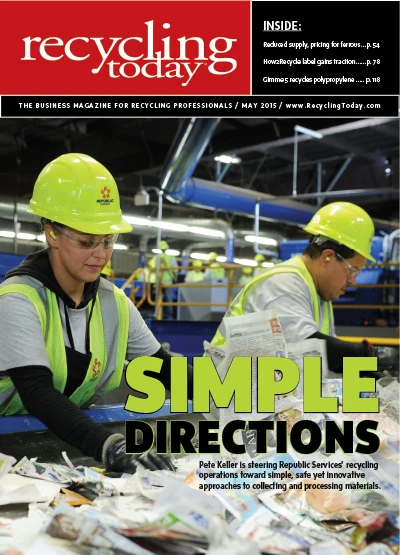Although ferrous scrap prices did not rebound in any meaningful way in early April, mill buying transactions have continued to reflect a stable market that has not produced a repeat performance of February’s steep price drop.
Transaction-based pricing for the early April buying period gathered by American Metal Market (AMM) showed a slight rebound in pricing for shredded scrap and prompt grades in the Midwest, though No. 1 heavy melting steel (HMS) dropped by yet a few more dollars per ton.
Although some recyclers reported increased export interest in the early spring, prices for HMS scrap also declined by a few more dollars per ton in the East Coast export market.
The relatively stable AMM April pricing continues a trend seen in the March figures calculated by MSA Inc., Pittsburgh, in its RMDAS (Raw Material Data Aggregation Service) pricing service.
According to RMDAS, mill buyers in March paid $1 per ton more for No. 1 HMS and just $2 per ton less for shredded scrap, though prompt grades dropped by an additional $16 per ton in (following a staggering $99 per ton drop in February).
As winter snow and ice receded from memory in early April, scrap processors reflected on a first quarter that yielded lower prices and a severe drop in supply flowing into their yards.
Recyclers contacted in early April cite flows that were down some 20 percent from the previous year, blaming severe winter weather and low prices that stifled peddler incentives. (For more on the supply deficit and its effects on the market, see the feature “Squeezing By” in this issue.)
Shredded and HMS prices likely stabilized first because the supply soon tapered off in reaction to the lower pricing and reduced demand from steel mills. Generation of prompt grades, meanwhile, continued despite tepid demand from mills.
Processors and traders looking forward to spring express some optimism but also admit to uncertainly as to the future direction of the market. Determining whether export demand will rebound is part of the guessing game.
“It seems there will be some renewed interest from overseas buyers in moving ferrous materials by containers when the West Coast port operations return to normal in the coming months,” says one recycler in California.
A recycler in Florida appears less confident that export activity will increase on the Atlantic or Gulf coasts. “The strength of the dollar and the U.S. economy compared to Europe and other regions will continue to make exporting a challenge,” he says.
On the scrap supply side, the spring thaw likely will jump-start the construction and demolition sectors in parts of the country where frozen ground, subzero temperatures and heavy precipitation put projects on hold for several months.
 The first quarter was not kind to the demolition industry, says one East Coast recycler. “There is a lot of pain among demo guys who bid positive on demo jobs (rather than charging), counting on scrap prices that were $80 to $100 higher, and now they are underwater in finishing their jobs,” he remarks.
The first quarter was not kind to the demolition industry, says one East Coast recycler. “There is a lot of pain among demo guys who bid positive on demo jobs (rather than charging), counting on scrap prices that were $80 to $100 higher, and now they are underwater in finishing their jobs,” he remarks.
“Projecting scrap prices is always a challenge for project estimators and everyone in our industry,” says a Texas-based demolition contractor. “With constantly fluctuating prices, any estimates on projects are always a risk you have to take, whether the current prices are high or low.”
If the construction activity is going to pick up, it is not yet reflected in the demand for steel as portrayed in American steel mill output statistics. According to the American Iron and Steel Institute (AISI), Washington, in the week ending April 4, 2015, domestic steel production was 1.6 million tons at a capacity rate of 67.7 percent.
That compares with production of 1.85 million tons in the week ending April 4, 2014, when the capacity rate was 77.1 percent. The 13.7 percent decrease in domestic steelmaking is foremost among the factors contributing to lower scrap pricing, and renewed construction activity would almost certainly help improve the picture.
Unfortunately, the production figure for the week ending April 4, 2015, also is down (by 1.7 percent) from the previous week that ended March 28, 2015, meaning that any anticipated spring thaw did not take place with the turn of the calendar to April.
The export market outlook was further affected when India’s government introduced a comprehensive new regimen for loading containerized scrap destined for the Indian market that calls for a three-to-five-minute video clip of the container loading process.
Initially, the new DGFT requirement was to take effect immediately, though an effort led by the Mumbai-based Metal Recycling Association of India (MRAI) resulted in a delay in the implementation until May 1, 2015. As of press time, the MRAI and other international recycling agencies continued to meet with the DGFT to urge considerable changes to the new policy.

Explore the May 2015 Issue
Check out more from this issue and find your next story to read.
Latest from Recycling Today
- Aqua Metals secures $1.5M loan, reports operational strides
- AF&PA urges veto of NY bill
- Aluminum Association includes recycling among 2025 policy priorities
- AISI applauds waterways spending bill
- Lux Research questions hydrogen’s transportation role
- Sonoco selling thermoformed, flexible packaging business to Toppan for $1.8B
- ReMA offers Superfund informational reports
- Hyster-Yale commits to US production






